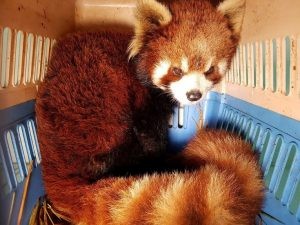Red pandas, with their fluffy red fur, adorable faces, and playful demeanor, often capture hearts worldwide. It’s easy to see why someone might dream of having one as a pet. Fueled by captivating online videos showcasing these creatures, the question arises: Can Panda Bears Be Pets? The simple and crucial answer is a resounding no. While the term “panda bear” might broadly evoke images of both giant pandas and red pandas, this article will specifically address red pandas and why keeping them as pets is detrimental and illegal.

Why Red Pandas Are Absolutely Not Suitable Pets
Despite their charming appearance, red pandas are wild animals with specific needs that cannot be met in a domestic setting. Attempting to keep a red panda as a pet is not only harmful to the animal but also poses risks to humans and contributes to the decline of this endangered species. Here are critical reasons why red pandas should never be considered pets:
Wild Animals with Natural Defenses
Don’t let the cuddly exterior fool you. Red pandas, classified as carnivores, possess sharp teeth, a strong bite force, and non-retractable, razor-sharp claws. These are not domesticated animals; they are equipped for survival in the wild. While these features are essential for climbing trees and foraging for bamboo in their natural habitat, they also serve as potent defense mechanisms. A red panda, if feeling threatened or stressed in a pet environment, can inflict serious injury. Their wild instincts and physical capabilities make them unsuitable for handling and interaction as pets.
Solitary and Stress-Sensitive Creatures
Red pandas are naturally solitary animals in the wild, primarily interacting with others only during the breeding season. They thrive in solitude and are not accustomed to constant company, whether from other red pandas or humans. This solitary nature means they are easily stressed by frequent handling and close human interaction. Unlike domesticated pets that seek companionship, red pandas prefer to be left alone. A home environment, with its noise, activity, and human presence, can be incredibly stressful for these animals, leading to behavioral issues and health problems. They are not animals that enjoy cuddling or being handled, despite their appearance suggesting otherwise.
Highly Specialized Dietary Needs
A red panda’s diet is incredibly specialized, with bamboo constituting around 95% of their intake in the wild. They consume an enormous quantity of bamboo leaves daily – estimated to be around 200,000 leaves! Providing this diet in a home environment is incredibly challenging and expensive. Zoos, with specialized resources, struggle to provide sufficient fresh bamboo and often supplement their diet with costly concentrated pellets to meet their nutritional needs. Furthermore, their high-fiber bamboo diet results in a significant amount of waste production – a single red panda can produce nearly a kilogram of feces every day. Meeting their dietary requirements and managing the associated mess is simply impractical for the average pet owner.
Illegal to Own and Trade
Perhaps the most critical reason against keeping red pandas as pets is their endangered status and the illegality of owning them. Red pandas are protected under international and national laws designed to prevent their extinction. The illegal pet trade is a significant threat to their wild populations. Anyone caught possessing a live red panda faces severe penalties, including hefty fines and potential imprisonment. Supporting the illegal pet trade by acquiring a red panda as a pet directly contributes to the decline of their wild population and undermines conservation efforts.
The Harmful Impact of Social Media and the Illegal Pet Trade
The rise of social media has inadvertently contributed to the demand for endangered animals as pets. Viral videos showcasing red pandas in domestic settings, often in unnatural and unsuitable conditions, create a false impression of them as cuddly companions. These videos, often garnering millions of views and comments expressing a desire to own a red panda, fuel the illegal pet trade. Wild red pandas are captured from their natural habitats and trafficked to urban areas to meet this demand, often suffering immensely during the process. This trade not only harms individual animals but also devastates wild populations, pushing them closer to extinction.
Supporting Red Panda Conservation
Instead of fueling the demand for red pandas as pets, we can contribute to their conservation. Supporting reputable organizations dedicated to red panda protection, such as the Red Panda Network, is a crucial step. Visiting red pandas in accredited zoos and wildlife parks that participate in breeding programs is a responsible way to appreciate these animals. These institutions often contribute to conservation efforts in the wild. By educating ourselves and others about the realities of red pandas and the dangers of the illegal pet trade, we can collectively help protect these amazing creatures in their natural habitat.
Next time you encounter a captivating video of a red panda seemingly kept as a pet, remember the reality: they are wild animals, not meant for domestication. Choose to support their conservation in the wild and appreciate them from a respectful distance, ensuring their survival for generations to come.